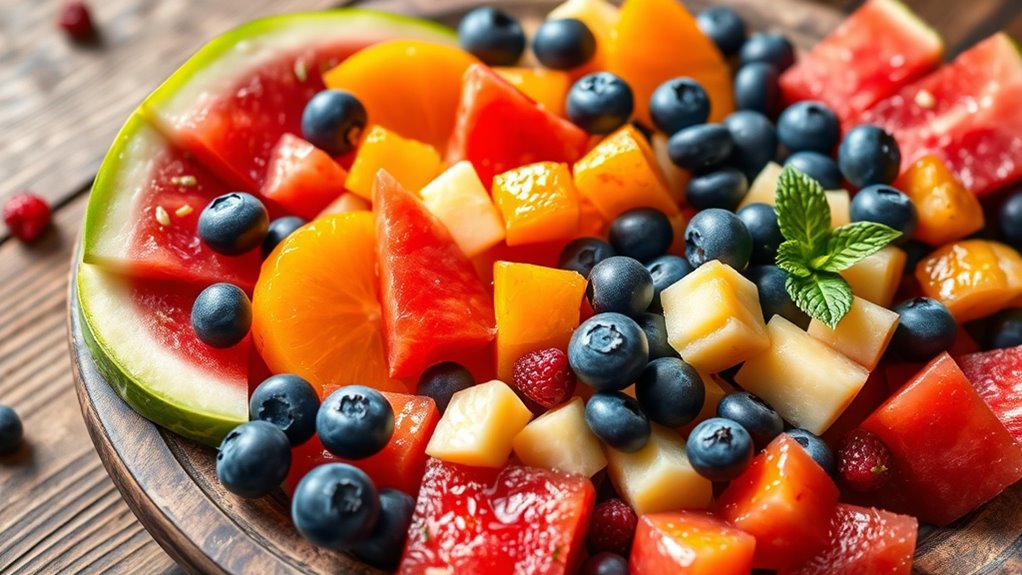You can make tasty, nutritious seasonal fruit treats for your dog by offering options like berries, apples (without seeds), and melons like watermelon or cantaloupe. These fruits provide essential vitamins, antioxidants, and hydration while making great homemade snacks. Always remove any seeds, rinds, or cores, and introduce new fruits gradually to check for sensitivities. If you’re curious about more safe fruit ideas and preparation tips, you’ll find plenty of helpful information below.
Key Takeaways
- Use seasonal fruits like berries, melons, and apples to create nutritious, hydrating treats for dogs.
- Prepare fruit treats by blending or mashing, then freezing in molds for easy summer snacks.
- Remove seeds, cores, and rinds to prevent choking and digestive issues.
- Avoid toxic ingredients such as grapes, raisins, and citrus peels.
- Introduce new fruits gradually and monitor for allergies or adverse reactions.

As the seasons change, offering your dog fresh, seasonal fruits can be a healthy and tasty way to enhance their diet. Incorporating fruits into their meals or as treats is a simple way to provide variety and essential nutrients. Homemade dog snacks made with seasonal fruits are a great alternative to store-bought treats, allowing you to control ingredients and avoid additives. When preparing these snacks, it’s important to keep fruit allergy awareness in mind. Dogs can have sensitivities or allergies to certain fruits, so start with small portions and observe for any adverse reactions. If your dog shows signs of itching, swelling, or gastrointestinal upset after trying a new fruit, discontinue use immediately and consult your veterinarian.
Seasonal fruits like berries, apples, and melons are especially popular choices for dog treats. Berries such as blueberries, raspberries, and strawberries are packed with antioxidants and vitamins that support your dog’s immune system. You can mash or blend them into ice cubes for a revitalizing summer treat or mix them into homemade dog treats like frozen pops. Apples are another excellent option, providing fiber and vitamins, but always remove the seeds and core before offering them to your dog. Melons like cantaloupe and watermelon are hydrating and low in calories, making them perfect for warm weather snacking. Just remember to remove the rind and seeds to prevent choking or digestive issues.
Creating homemade dog snacks with seasonal fruits is straightforward. You can mash fruits and freeze them in silicone molds for a cool summer snack or combine them with dog-safe ingredients like oats or peanut butter for a more substantial treat. Just be cautious with ingredients that are toxic to dogs, such as grapes, raisins, or citrus peels. Always research or ask your vet if you’re unsure about a particular fruit or ingredient. It’s also wise to introduce new fruits gradually and in moderation to gauge your dog’s response. Additionally, using safe dog-friendly fruits helps ensure your pet’s health and enjoyment.
Frequently Asked Questions
Can Dogs Eat Dried or Cooked Seasonal Fruits Safely?
Yes, dogs can safely eat dried or cooked seasonal fruits if you carefully consider fruit preservation and seasonal fruit sourcing. Always remove seeds, pits, and stems, as these can be toxic. Cooking can make fruits easier for your dog to digest, but avoid added sugars or preservatives. Properly dried or cooked fruits, sourced responsibly, make a healthy treat, but always introduce new foods gradually and consult your vet if unsure.
Are There Any Fruits That Are Toxic to Dogs During Certain Seasons?
Think of your dog as a vigilant gardener, cautious of certain seasonal fruits that could be toxic. During specific times, like spring or fall, seasonal fruit allergies might make some fruits dangerous, especially if stored improperly. For example, grapes and raisins can be harmful year-round, but moldy or spoiled fruit poses risks during seasonal storage. Always check for signs of toxicity and store fruits securely to protect your furry friend.
How Much Seasonal Fruit Can I Give My Dog Daily?
You should give your dog no more than a few small pieces of seasonal fruit daily, focusing on portion control to prevent upset stomachs. Offer a variety of fruits to guarantee balanced nutrients, but avoid overfeeding any one type. Remember, moderation is key—think of it as a treat rather than a meal. Always monitor for any adverse reactions, and consult your vet if you’re unsure about specific fruits.
Should Seasonal Fruit Treats Replace Regular Dog Food?
Like a wise old gardener tending to delicate blooms, you shouldn’t let seasonal fruit treats replace your dog’s regular food. While seasonal fruit varieties offer nutritional benefits like vitamins and antioxidants, they lack essential nutrients dogs need daily. Think of fruit as a delightful supplement, not the main course. Keep your dog’s diet balanced by offering treats in moderation, ensuring a healthy, happy companion without sacrificing their core nutrition.
How Can I Prepare Seasonal Fruits to Avoid Choking Hazards?
To prepare seasonal fruits safely for your dog, start by slicing the fruit into small, manageable pieces to prevent choking. Always remove seeds, pits, and stems, as they can be toxic or cause choking hazards. Make sure the pieces are soft enough for your dog to chew easily. By following these steps, you guarantee your furry friend enjoys healthy, safe treats without any risk of choking.
Conclusion
Now that you know which seasonal fruits are safe and delightful for your dog, you can create colorful, nourishing treats that brighten their day like a splash of sunshine. Imagine your furry friend’s tail wagging happily as they enjoy these natural goodies—a true feast for their senses. By sharing these healthy, seasonal treats, you’re not just feeding them—you’re painting moments of joy and love in the vibrant canvas of their life.










